A Comparative Assessment of Machine Learning Models for Landslide Susceptibility Mapping in the Rugged Terrain of Northern Pakistan
Abstract
1. Introduction
2. Materials and Methods
2.1. Description of the Study Area
2.2. Data Acquisition and Data Preparation
2.3. Preparation of Landslide Inventory
2.4. Selection of Landslide Influencing Factors (LIFs)
2.5. Evaluation of Landslide Influencing Factors
2.6. Machine Learning Algorithms and Susceptibility Modeling
2.6.1. Random Forest (RF)
2.6.2. Support Vector Machine (SVM)
2.6.3. Maximum Entropy (maxENT)
2.6.4. Gradient-boosting Machine (GBM)
2.6.5. Logistic Regression (LR)
2.7. Performance Evaluation of Models
3. Results
3.1. Importance and Contribution of Landslide Influencing Factors (LIFs)
3.2. Landslide Susceptibility Maps (LSMs)
3.3. Performance Evaluation of Models and Analysis of the Results
4. Discussions
4.1. Evaluation of LIFs and Modeling Criteria
4.2. Performances of Susceptibility Modeling
4.3. Realtime Validation of Modeled Results
5. Conclusions
- The 12 selected influencing factors (i.e., elevation, slope, aspect, TWI, TPI, distance to drainage, distance to fault, distance to road, NDVI, rainfall, LCLU, and geological layer) were useful when scanned through the IGR test, and none of the LIFs had a multicollinearity problem.
- The extracted 70% of the sample data used for the tuning and training of the models showed a good agreement with the tuning parameters, which helped in achieving higher accuracies during the training process.
- Apart from predicting large-scale landslides, a visual analysis (Figure 12) of modeled susceptibility maps indicated that all five models were also able to predict very-small-scale landslides, which can provide a better understanding to identify landslide risks in the region.
- The descriptive analysis of the LIF contribution showed that the area lying in the elevation range of 505 to 3895 m, with NE–WSW facing slopes, near the drainage networks, with LCLU other than snow, dense vegetation, cultivated land, and water bodies could be attributed directly to the slope failure manifestation in the study area, which can experience a relatively higher chance of landslide occurrences in the future.
- During the validation process, using 30% of the samples, the results showed that SVM (AUC = 0.969, POA = 2669), RF (AUC = 0.967, POA = 2656), and GBM (AUC = 0.967, POA = 2623) were the top three performers, leaving behind maxENT (AUC = 0.872, POA = 1761) and LR (AUC = 0.836, POA = 1299). The validation through the calculation of other parameters (precision, recall, ACC, F1 score, and MCC) showed a similar trend in terms of the performance sequence of the models.
- Exhibiting minimal differences in terms of all the evaluated parameters with SVM and RF, the study also found the better performance of the GBM model for LSM in the region.
- SVM > RF > GBM > maxENT > LR represents the overall performance ranking with decreasing POA values.
- Conclusively, these modeled results can be helpful in understanding and assessing the scope of landslide problems in this area and can also provide help in risk reduction and mitigation measures in this region as well as in other parts of the globe with similar topographical, climatic, and geological conditions.
Supplementary Materials
Author Contributions
Funding
Institutional Review Board Statement
Informed Consent Statement
Data Availability Statement
Acknowledgments
Conflicts of Interest
References
- Corominas, J.; van Westen, C.; Frattini, P.; Cascini, L.; Malet, J.P.; Fotopoulou, S.; Catani, F.; Van Den Eeckhaut, M.; Mavrouli, O.; Agliardi, F.; et al. Recommendations for the quantitative analysis of landslide risk. Bull. Eng. Geol. Environ. 2014, 73, 209–263. [Google Scholar] [CrossRef]
- Mondini, A.C.; Guzzetti, F.; Chang, K.-T.; Monserrat, O.; Martha, T.R.; Manconi, A. Landslide failures detection and mapping using Synthetic Aperture Radar: Past, present and future. Earth Sci. Rev. 2021, 216, 103574. [Google Scholar] [CrossRef]
- Segoni, S.; Tofani, V.; Rosi, A.; Catani, F.; Casagli, N. Combination of Rainfall Thresholds and Susceptibility Maps for Dynamic Landslide Hazard Assessment at Regional Scale. Front. Earth Sci. 2018, 6, 85. [Google Scholar] [CrossRef]
- Brabb, E.E. Proposal for Worldwide Landslide Hazard Maps. In Proceedings of the Seventh International Conference and Field Workshop on Landslides in Czech and Slovak Republics, Czech Republic and Slovakia, 28 August–15 September 1993; Rotterdam: Brookfield, VT, USA, 1993; pp. 15–27. [Google Scholar]
- Guzzetti, F.; Mondini, A.C.; Cardinali, M.; Fiorucci, F.; Santangelo, M.; Chang, K.-T. Landslide inventory maps: New tools for an old problem. Earth-Sci. Rev. 2012, 112, 42–66. [Google Scholar] [CrossRef]
- Ma, Z.; Mei, G.; Piccialli, F. Machine learning for landslides prevention: A survey. Neural Comput. Appl. 2020, 33, 10881–10907. [Google Scholar] [CrossRef]
- Ballabio, C.; Sterlacchini, S. Support Vector Machines for Landslide Susceptibility Mapping: The Staffora River Basin Case Study, Italy. Math. Geosci. 2012, 44, 47–70. [Google Scholar] [CrossRef]
- Brenning, A. Spatial prediction models for landslide hazards: Review, comparison and evaluation. Nat. Hazards Earth Syst. Sci. 2005, 5, 853–862. [Google Scholar] [CrossRef]
- Chen, S.; Miao, Z.; Wu, L.; He, Y. Application of an Incomplete Landslide Inventory and One Class Classifier to Earthquake-Induced Landslide Susceptibility Mapping. IEEE J. Sel. Top. Appl. Earth Obs. Remote Sens. 2020, 13, 1649–1660. [Google Scholar] [CrossRef]
- Lee, S.; Hong, S.-M.; Jung, H.-S. A Support Vector Machine for Landslide Susceptibility Mapping in Gangwon Province, Korea. Sustainability 2017, 9, 48. [Google Scholar] [CrossRef]
- Park, N.W. Using maximum entropy modeling for landslide susceptibility mapping with multiple geoenvironmental data sets. Environ. Earth Sci. 2015, 73, 937–949. [Google Scholar] [CrossRef]
- Fell, R.; Corominas, J.; Bonnard, C.; Cascini, L.; Leroi, E.; Savage, W.Z. Guidelines for landslide susceptibility, hazard and risk zoning for land use planning. Eng. Geol. 2008, 102, 85–98. [Google Scholar] [CrossRef]
- Xue, L.; Xiaoli, L.; Jinggang, L.; Qiuliang, W.; Wulin, L.; Lifen, Z. Factor analysis of earthquake-induced geological disasters of the M7. 0 Lushan earthquake in China. Geod. Geodyn. 2013, 4, 22–29. [Google Scholar] [CrossRef][Green Version]
- Tsangaratos, P.; Ilia, I. Chapter 24-Applying Machine Learning Algorithms in Landslide Susceptibility Assessments. In Handbook of Neural Computation; Samui, P., Sekhar, S., Balas, V.E., Eds.; Academic Press: Cambridge, MA, USA, 2017; pp. 433–457. ISBN 978-0-12-811318-9. [Google Scholar]
- Kavzoglu, T.; Colkesen, I.; Sahin, E.K. Machine Learning Techniques in Landslide Susceptibility Mapping: A Survey and a Case Study. In Landslides: Theory, Practice and Modelling; Advances in Natural and Technological Hazards Research 50; Pradhan, S.P., Vishal, V., Singh, T.N., Eds.; Springer International Publishing: Berlin/Heidelberg, Germany, 2019; pp. 283–301. ISBN 9783319773766. [Google Scholar]
- Iovine, G.; Cohen, D. Advanced methods in landslide modelling. Nat. Hazards 2014, 73, 1–4. [Google Scholar] [CrossRef]
- Choi, K.Y.; Cheung, R.W.M. Landslide disaster prevention and mitigation through works in Hong Kong. J. Rock Mech. Geotech. Eng. 2013, 5, 354–365. [Google Scholar] [CrossRef]
- Pourghasemi, H.R.; Teimoori Yansari, Z.; Panagos, P.; Pradhan, B. Analysis and evaluation of landslide susceptibility: A review on articles published during 2005–2016 (periods of 2005–2012 and 2013–2016). Arab. J. Geosci. 2018, 11, 193. [Google Scholar] [CrossRef]
- Guzzetti, F.; Carrara, A.; Cardinali, M.; Reichenbach, P. Landslide hazard evaluation: A review of current techniques and their application in a multi-scale study, Central Italy. Geomorphology 1999, 31, 181–216. [Google Scholar] [CrossRef]
- Lombardo, L.; Mai, P.M. Presenting logistic regression-based landslide susceptibility results. Eng. Geol. 2018, 244, 14–24. [Google Scholar] [CrossRef]
- Tien Bui, D.; Tuan, T.A.; Klempe, H.; Pradhan, B.; Revhaug, I. Spatial prediction models for shallow landslide hazards: A comparative assessment of the efficacy of support vector machines, artificial neural networks, kernel logistic regression, and logistic model tree. Landslides 2016, 13, 361–378. [Google Scholar] [CrossRef]
- Pradhan, B. A comparative study on the predictive ability of the decision tree, support vector machine and neuro-fuzzy models in landslide susceptibility mapping using GIS. Comput. Geosci. 2013, 51, 350–365. [Google Scholar] [CrossRef]
- Dou, J.; Yunus, A.P.; Tien Bui, D.; Merghadi, A.; Sahana, M.; Zhu, Z.; Chen, C.-W.; Khosravi, K.; Yang, Y.; Pham, B.T. Assessment of advanced random forest and decision tree algorithms for modeling rainfall-induced landslide susceptibility in the Izu-Oshima Volcanic Island, Japan. Sci. Total Environ. 2019, 662, 332–346. [Google Scholar] [CrossRef]
- Sahin, E.K. Assessing the predictive capability of ensemble tree methods for landslide susceptibility mapping using XGBoost, gradient boosting machine, and random forest. SN Appl. Sci. 2020, 2, 1308. [Google Scholar] [CrossRef]
- Hong, H.; Pourghasemi, H.R.; Pourtaghi, Z.S. Landslide susceptibility assessment in Lianhua County (China): A comparison between a random forest data mining technique and bivariate and multivariate statistical models. Geomorphology 2016, 259, 105–118. [Google Scholar] [CrossRef]
- Kosicki, J.Z. Should topographic metrics be considered when predicting species density of birds on a large geographical scale? A case of Random Forest approach. Ecol. Modell. 2017, 349, 76–85. [Google Scholar] [CrossRef]
- Kosicki, J.Z. Generalised Additive Models and Random Forest Approach as effective methods for predictive species density and functional species richness. Environ. Ecol. Stat. 2020, 27, 273–292. [Google Scholar] [CrossRef]
- Friedman, J.H. Greedy function approximation: A gradient boosting machine. Ann. Stat. 2001, 29, 1189–1232. [Google Scholar] [CrossRef]
- Merghadi, A.; Yunus, A.P.; Dou, J.; Whiteley, J.; ThaiPham, B.; Bui, D.T.; Avtar, R.; Abderrahmane, B. Machine learning methods for landslide susceptibility studies: A comparative overview of algorithm performance. Earth-Sci. Rev. 2020, 207, 103225. [Google Scholar] [CrossRef]
- Arabameri, A.; Saha, S.; Roy, J.; Chen, W.; Blaschke, T.; Bui, D.T. Landslide susceptibility evaluation and management using different machine learning methods in the Gallicash River Watershed, Iran. Remote Sens. 2020, 12, 475. [Google Scholar] [CrossRef]
- Xing, Y.; Yue, J.; Guo, Z.; Chen, Y.; Hu, J.; Travé, A. Large-Scale Landslide Susceptibility Mapping Using an Integrated Machine Learning Model: A Case Study in the Lvliang Mountains of China. Front. Earth Sci. 2021, 9, 622. [Google Scholar] [CrossRef]
- Merghadi, A.; Abderrahmane, B.; Tien Bui, D. Landslide susceptibility assessment at Mila basin (Algeria): A comparative assessment of prediction capability of advanced machine learning methods. ISPRS Int. J. Geo-Inf. 2018, 7, 268. [Google Scholar] [CrossRef]
- Wang, Z.; Liu, Q.; Liu, Y. Mapping landslide susceptibility using machine learning algorithms and GIS: A case study in Shexian county, Anhui province, China. Symmetry 2020, 12, 1954. [Google Scholar] [CrossRef]
- Qing, F.; Zhao, Y.; Meng, X.; Su, X.; Qi, T.; Yue, D. Application of machine learning to debris flow susceptibility mapping along the China-Pakistan Karakoram Highway. Remote Sens. 2020, 12, 2933. [Google Scholar] [CrossRef]
- Ali, S.A.; Parvin, F.; Vojteková, J.; Costache, R.; Linh, N.T.T.; Pham, Q.B.; Vojtek, M.; Gigović, L.; Ahmad, A.; Ghorbani, M.A. GIS-based landslide susceptibility modeling: A comparison between fuzzy multi-criteria and machine learning algorithms. Geosci. Front. 2021, 12, 857–876. [Google Scholar] [CrossRef]
- Wolpert, D.H. The Lack of a Priori Distinctions between Learning Algorithms. Neural Comput. 1996, 8, 1341–1390. [Google Scholar] [CrossRef]
- Ray, R.L. Remote Sensing Approaches and Related Techniques to Map and Study Landslides; Lazzari, M., Ed.; IntechOpen: Rijeka, Croatia, 2020; Chapter 2; ISBN 9781789858242. [Google Scholar]
- Tariq, S.; Gomes, C. Landslide Environment in Pakistan after the Earthquake-2005: Information Revisited to Develop Safety Guidelines for Minimizing Future Impacts. J. Geogr. Nat. Disasters 2017, 7, 1–11. [Google Scholar] [CrossRef]
- Rafiq, L.; Blaschke, T. Disaster risk and vulnerability in Pakistan at a district level. Geomat. Nat. Hazards Risk 2012, 3, 324–341. [Google Scholar] [CrossRef]
- International Federation of Red Cross and Crescent Societies. World Disasters Report; IFRC: Geneva, Switzerland, 2003. [Google Scholar]
- Ahmed, M.F.; Rogers, J.D.; Ismail, E.H. A regional level preliminary landslide susceptibility study of the upper Indus river basin. Eur. J. Remote Sens. 2014, 47, 343–373. [Google Scholar] [CrossRef]
- Ali, S.; Haider, R.; Abbas, W.; Basharat, M.; Reicherter, K. Empirical assessment of rockfall and debris flow risk along the Karakoram Highway, Pakistan. Nat. Hazards 2021, 106, 2437–2460. [Google Scholar] [CrossRef]
- Faisal, S.; Larson, K.P.; King, J.; Cottle, J.M. Rifting, subduction and collisional records from pluton petrogenesis and geochronology in the Hindu Kush, NW Pakistan. Gondwana Res. 2016, 35, 286–304. [Google Scholar] [CrossRef]
- Pêcher, A.; Seeber, L.; Guillot, S.; Jouanne, F.; Kausar, A.; Latif, M.; Majid, A.; Mahéo, G.; Mugnier, J.L.; Rolland, Y.; et al. Stress field evolution in the northwest Himalayan syntaxis, northern Pakistan. Tectonics 2008, 27. [Google Scholar] [CrossRef]
- Froude, M.J.; Petley, D.N. Global fatal landslide occurrence from 2004 to 2016. Nat. Hazards Earth Syst. Sci. 2018, 18, 2161–2181. [Google Scholar] [CrossRef]
- Kirschbaum, D. Global Catalog of Rainfall-Triggered Landslides for Spatial and Temporal Hazard Characterization. In Landslide Science for a Safer Geoenvironment; Sassa, K., Canuti, P., Yin, Y., Eds.; Springer International Publishing: Cham, Switzerland, 2014; pp. 809–814. ISBN 9783319050508. [Google Scholar]
- Kirschbaum, D.; Stanley, T.; Zhou, Y. Spatial and temporal analysis of a global landslide catalog. Geomorphology 2015, 249, 4–15. [Google Scholar] [CrossRef]
- Ågren, A.M.; Lidberg, W.; Strömgren, M.; Ogilvie, J.; Arp, P.A. Evaluating digital terrain indices for soil wetness mapping-a Swedish case study. Hydrol. Earth Syst. Sci. 2014, 18, 3623–3634. [Google Scholar] [CrossRef]
- Encyclopedia of GIS; Shekhar, S., Xiong, H., Zhou, X., Eds.; Springer International Publishing: Cham, Switzerland, 2017; ISBN 9783319178844. [Google Scholar]
- Rouse, J.W.; Haas, R.H.; Schell, J.A.; Deeering, D. Monitoring vegetation systems in the Great Plains with ERTS (Earth Resources Technology Satellite). In Proceedings of the Third Earth Resources Technology Satellite-1, Washington, DC, USA, 10–14 December 1973. [Google Scholar]
- Blaschke, T. Object based image analysis for remote sensing. ISPRS J. Photogramm. Remote Sens. 2010, 65, 2–16. [Google Scholar] [CrossRef]
- Quinlan, J.R. Induction of decision trees. Mach. Learn. 1986, 1, 81–106. [Google Scholar] [CrossRef]
- Menard, S.W. Applied Logistic Regression Analysis; Sage Publications: Thousand Oaks, CA, USA, 1995; ISBN 0803957572. [Google Scholar]
- Alin, A. Multicollinearity. Wiley Interdiscip. Rev. Comput. Stat. 2010, 2, 370–374. [Google Scholar] [CrossRef]
- Haitovsky, Y. Multicollinearity in Regression Analysis Comment. Rev. Econ. Stat. 1969, 51, 465. [Google Scholar] [CrossRef]
- Breiman, L. Random forests. Mach. Learn. 2001, 45, 5–32. [Google Scholar] [CrossRef]
- James, G.; Witten, D.; Hastie, T.; Tibshirani, R. An Introduction to Statistical Learning, Springer Texts; Springers: New York, NY, USA, 2013; ISBN 9780387781884. [Google Scholar]
- Kavzoglu, T.; Colkesen, I. A kernel functions analysis for support vector machines for land cover classification. Int. J. Appl. Earth Obs. Geoinf. 2009, 11, 352–359. [Google Scholar] [CrossRef]
- Xu, C.; Dai, F.; Xu, X.; Lee, Y.H. GIS-based support vector machine modeling of earthquake-triggered landslide susceptibility in the Jianjiang River watershed, China. Geomorphology 2012, 145–146, 70–80. [Google Scholar] [CrossRef]
- Phillips, S.J.; Anderson, R.P.; Schapire, R.E. Maximum entropy modeling of species geographic distributions. Ecol. Modell. 2006, 190, 231–259. [Google Scholar] [CrossRef]
- Elith, J.; Phillips, S.J.; Hastie, T.; Dudík, M.; Chee, Y.E.; Yates, C.J. A statistical explanation of MaxEnt for ecologists. Divers. Distrib. 2011, 17, 43–57. [Google Scholar] [CrossRef]
- Micheletti, N.; Foresti, L.; Robert, S.; Leuenberger, M.; Pedrazzini, A.; Jaboyedoff, M.; Kanevski, M. Machine Learning Feature Selection Methods for Landslide Susceptibility Mapping. Math. Geosci. 2014, 46, 33–57. [Google Scholar] [CrossRef]
- França, S.; Cabral, H.N. Predicting fish species richness in estuaries: Which modelling technique to use? Environ. Model. Softw. 2015, 66, 17–26. [Google Scholar] [CrossRef]
- McCullagh, P.; Nelder, J.A. Generalized Linear Models (Monographs on Statistics and Applied Probability), 2nd ed.; Chapman and Hall/CRC: Boca Raton, FL, USA, 1989; ISBN 0412317605. [Google Scholar]
- Wang, H.; Zhang, L.; Yin, K.; Luo, H.; Li, J. Landslide identification using machine learning. Geosci. Front. 2020. [Google Scholar] [CrossRef]
- Breiman, L.; Friedman, J.H.; Olshen, R.A.; Stone, C.J. Classification and Regression Trees; Chapman and Hall/CRC: Boca Raton, FL, USA, 1984; ISBN 9781351460491. [Google Scholar]
- Jenks, G.F. The Data Model Concept in Statistical Mapping. Int. Yearb. Cartogr. 1967, 7, 186–190. [Google Scholar]
- Flach, P. ROC Analysis. In Encyclopedia of Machine Learning; Springer: Berlin/Heidelberg, Germany, 2011; pp. 869–875. [Google Scholar]
- Swets, J.A. Measuring the accuracy of diagnostic systems. Science 1988, 240, 1285–1293. [Google Scholar] [CrossRef]
- Brenning, A. Statistical geocomputing combining R and SAGA: The example of landslide susceptibility analysis with generalized additive models. Hambg. Beiträge Zur Phys. Geogr. Und Landsch. 2008, 19, 410. [Google Scholar]
- Jain, A.K.; Duin, R.P.W.; Mao, J. Statistical pattern recognition: A review. IEEE Trans. Pattern Anal. Mach. Intell. 2000. [Google Scholar] [CrossRef]
- Koukis, G.; Rozos, D.; Hadzinakos, I. Relationship between rainfall and landslides in the formations of Achaia County, Greece. In Proceedings of the International Symposium on Engineering Geology and the Environment, Athens, Greece, 23–27 June 1997. [Google Scholar]
- Dai, F.C.; Lee, C.F.; Ngai, Y.Y. Landslide risk assessment and management: An overview. Eng. Geol. 2002, 64, 65–87. [Google Scholar] [CrossRef]
- Yao, X.; Tham, L.G.; Dai, F.C. Landslide susceptibility mapping based on Support Vector Machine: A case study on natural slopes of Hong Kong, China. Geomorphology 2008, 101, 572–582. [Google Scholar] [CrossRef]
- Goetz, J.N.; Brenning, A.; Petschko, H.; Leopold, P. Evaluating machine learning and statistical prediction techniques for landslide susceptibility modeling. Comput. Geosci. 2015, 81, 1–11. [Google Scholar] [CrossRef]
- Yilmaz, I. Comparison of landslide susceptibility mapping methodologies for Koyulhisar, Turkey: Conditional probability, logistic regression, artificial neural networks, and support vector machine. Environ. Earth Sci. 2010, 61, 821–836. [Google Scholar] [CrossRef]
- Youssef, A.M.; Pourghasemi, H.R. Landslide susceptibility mapping using machine learning algorithms and comparison of their performance at Abha Basin, Asir Region, Saudi Arabia. Geosci. Front. 2021, 12, 639–655. [Google Scholar] [CrossRef]
- Kalantar, B.; Ueda, N.; Saeidi, V.; Ahmadi, K.; Halin, A.A.; Shabani, F. Landslide susceptibility mapping: Machine and ensemble learning based on remote sensing big data. Remote Sens. 2020, 12, 1737. [Google Scholar] [CrossRef]
- Raso, E.; Di Martire, D.; Cevasco, A.; Calcaterra, D.; Scarpellini, P.; Firpo, M. Evaluation of Prediction Capability of the MaxEnt and Frequency Ratio Methods for Landslide Susceptibility in the Vernazza Catchment (Cinque Terre, Italy). In Applied Geology: Approaches to Future Resource Management; De Maio, M., Tiwari, A.K., Eds.; Springer International Publishing: Cham, Switzerland, 2020; pp. 299–316. ISBN 978-3-030-43953-8. [Google Scholar]
- Pandey, V.K.; Pourghasemi, H.R.; Sharma, M.C. Landslide susceptibility mapping using maximum entropy and support vector machine models along the highway corridor, Garhwal Himalaya. Geocarto Int. 2018, 35, 168–187. [Google Scholar] [CrossRef]
- Felicísimo, Á.M.; Cuartero, A.; Remondo, J.; Quirós, E. Mapping landslide susceptibility with logistic regression, multiple adaptive regression splines, classification and regression trees, and maximum entropy methods: A comparative study. Landslides 2013, 10, 175–189. [Google Scholar] [CrossRef]
- Dawn Six Killed as Heavy Rains Pound KP 2019. 2019. Available online: https://www.dawn.com/news/1496462. (accessed on 20 May 2020).
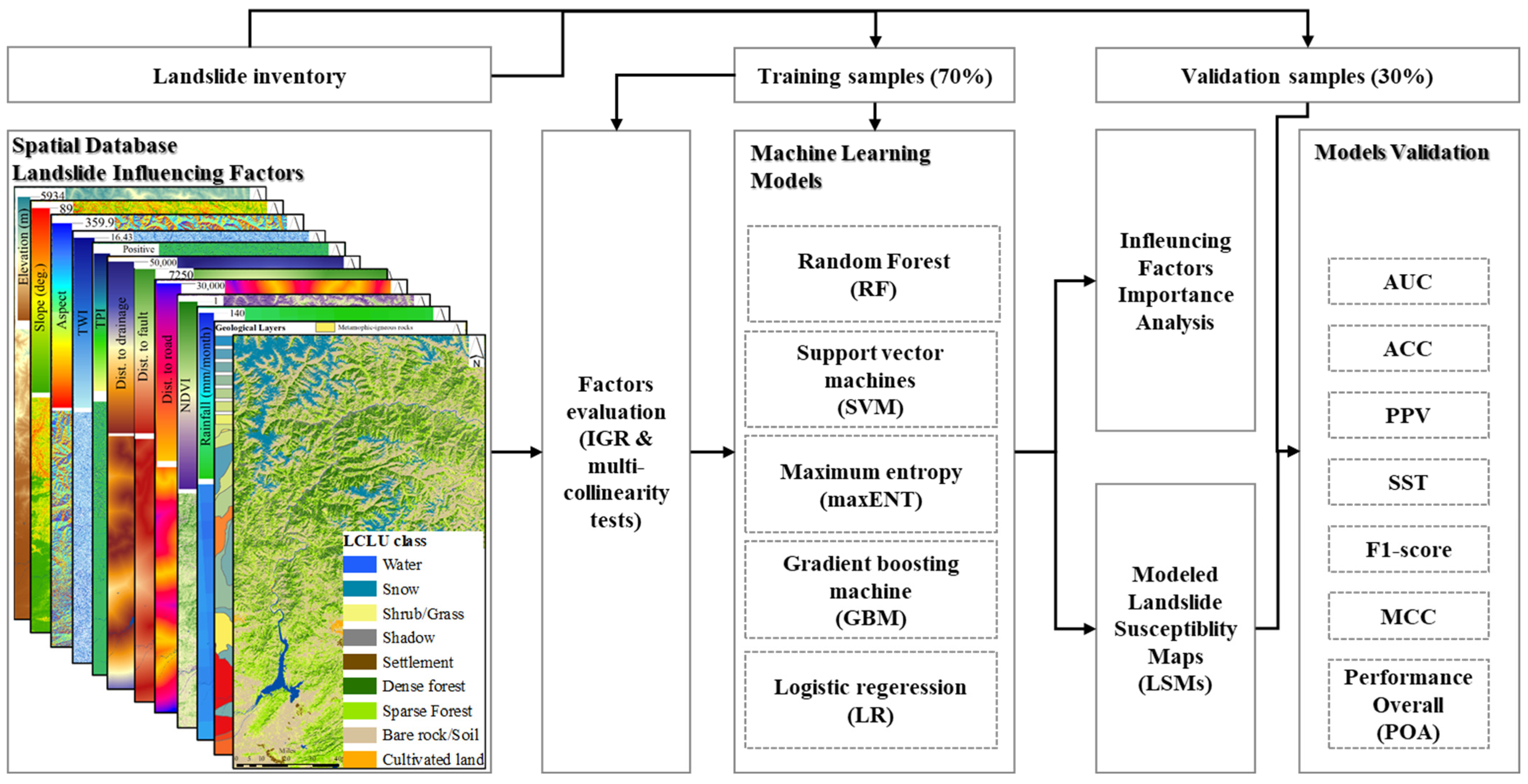
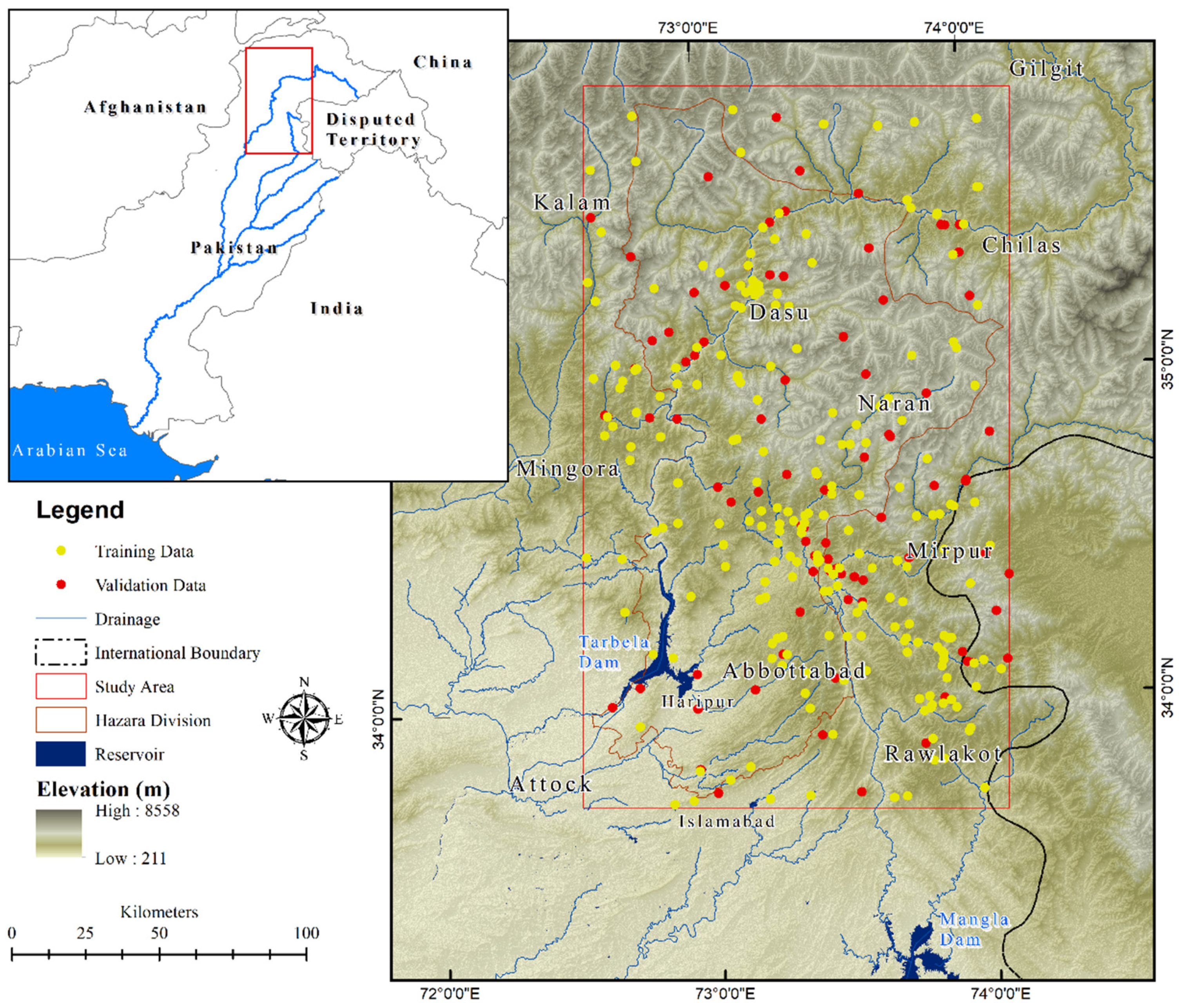



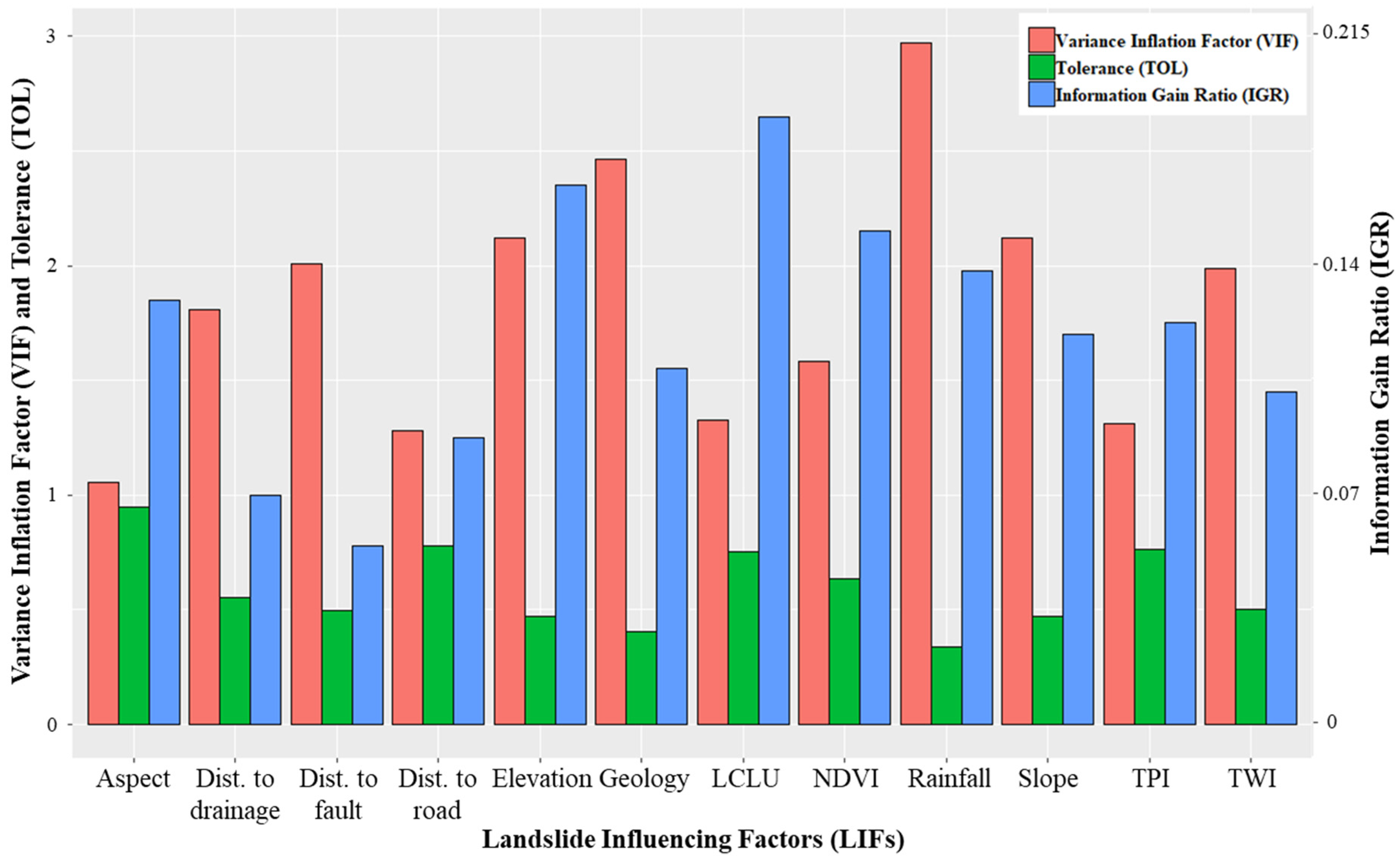
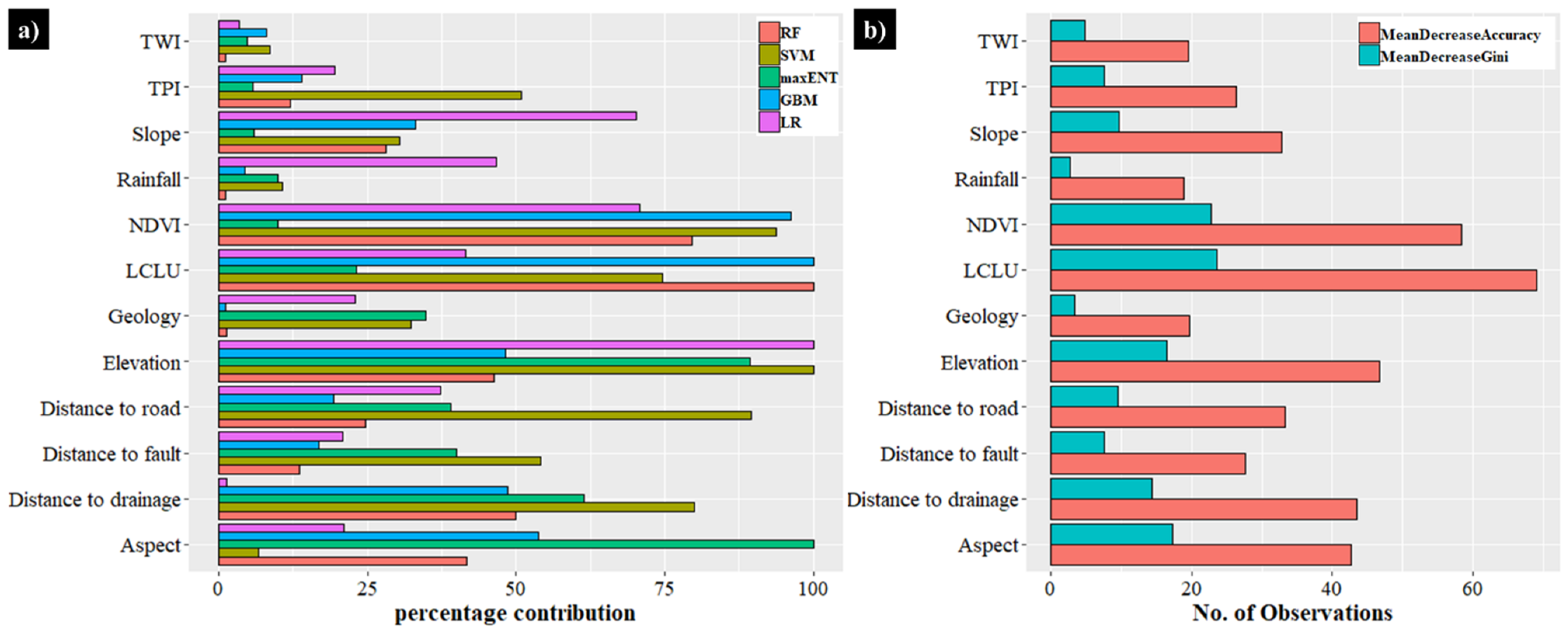

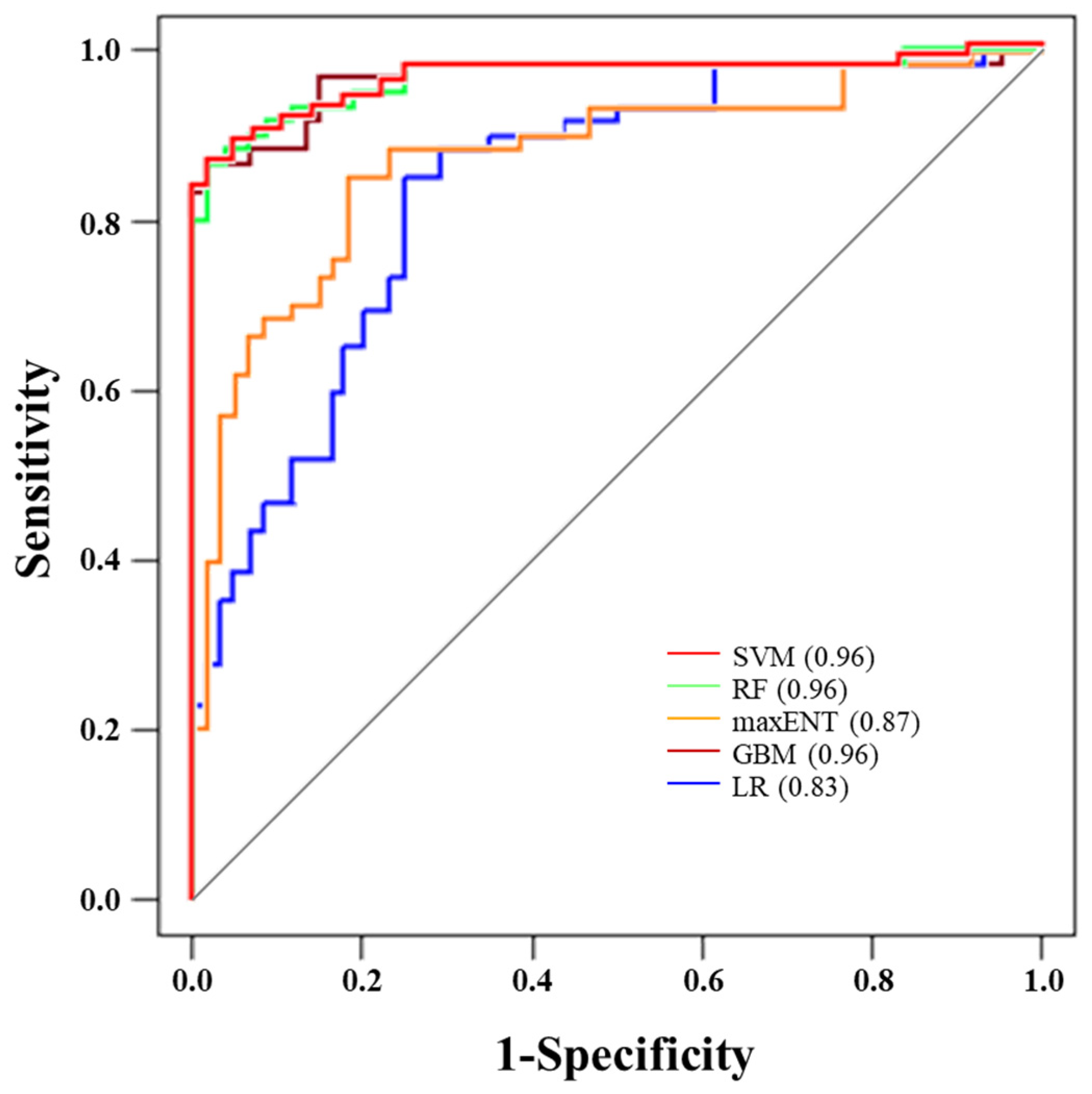
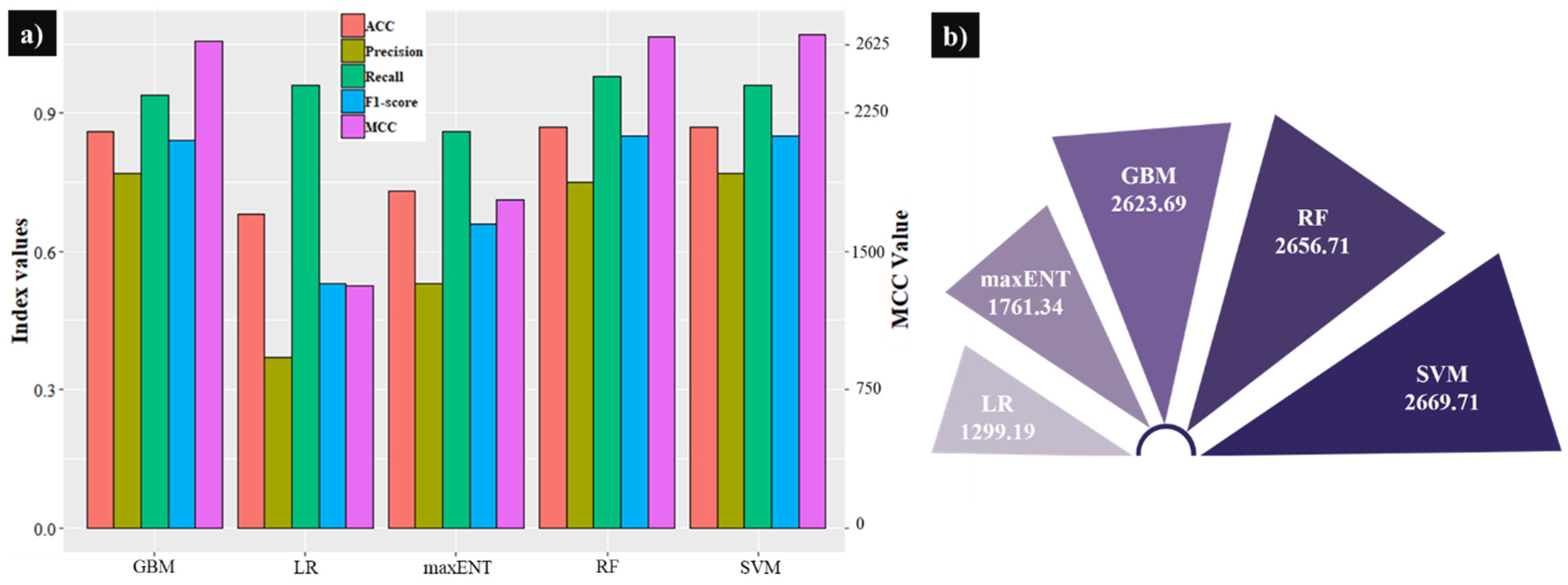
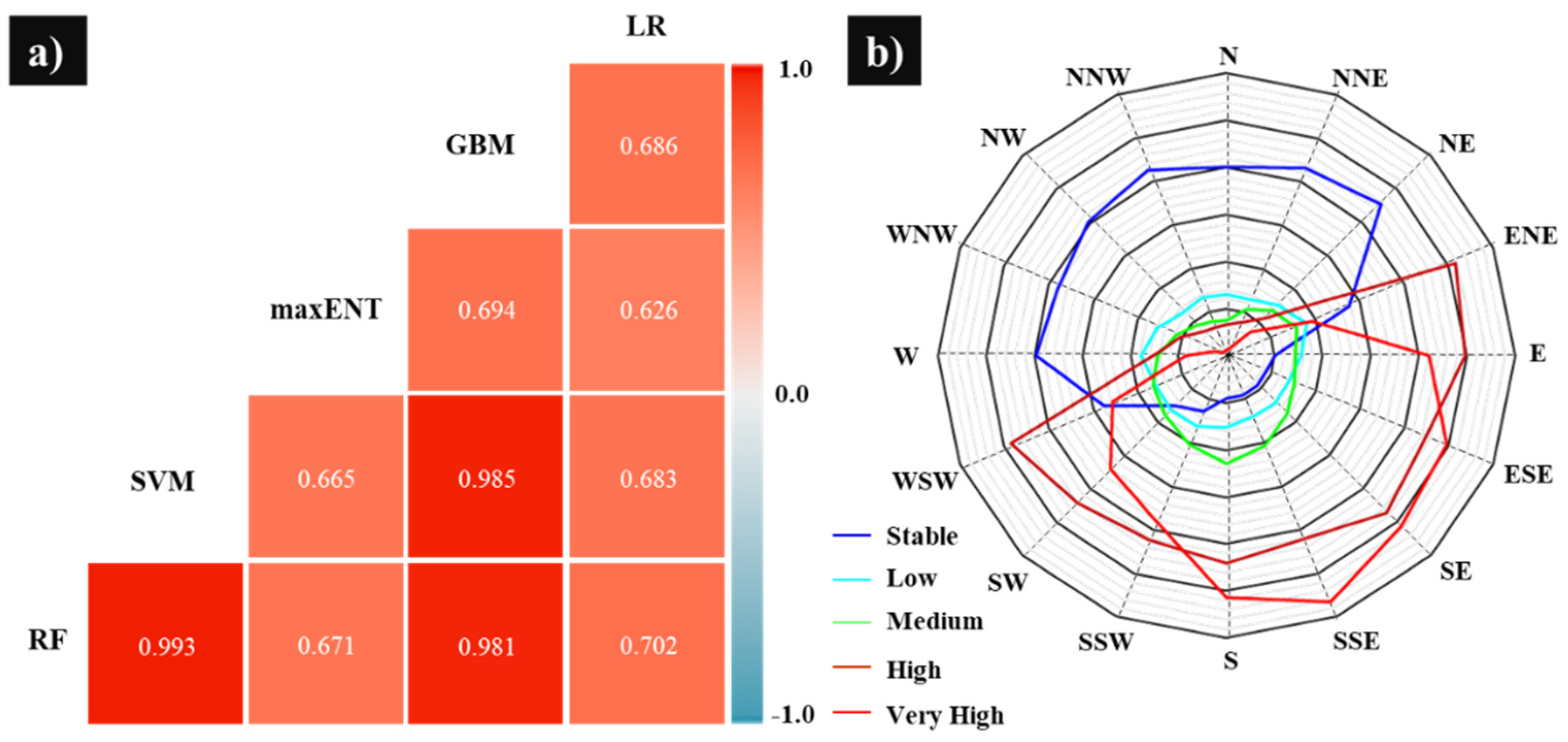
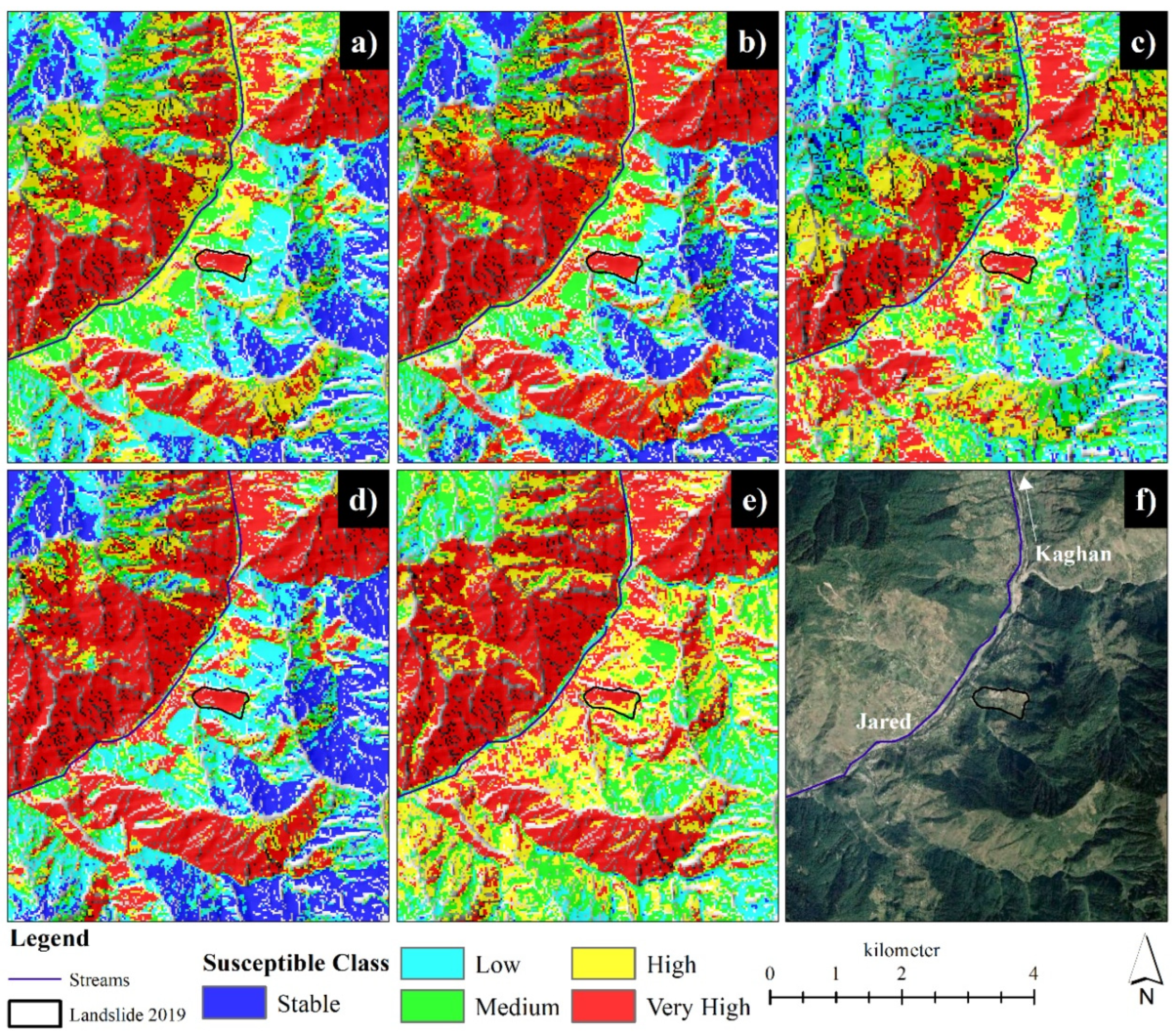
| S. No. | Influencing Factor | Input Data | Description |
|---|---|---|---|
| 1 | Elevation | SRTM DEM | Digital elevation of the terrain surface. Values vary between 279 and 5934 m (Figure 5a). |
| 2 | Slope | SRTM DEM | A most crucial parameter that has a direct influence on slope failure and susceptibility. Values are up to 89 degrees (Figure 5b). |
| 3 | Aspect | SRTM DEM | The exposure of the slope to conditions such as sunlight, temperature, and winds. An important causative factor to susceptibility (Figure 5c). |
| 4 | TWI | SRTM DEM | TWI [48] is an index used to quantify topographic control of hydrological processes. Values vary from −3.7 to 16.43 (Figure 5d). |
| 5 | TPI | SRTM DEM | TPI [48] is an index that reflects the morphology of the topography (Figure 5e). |
| 6 | Distance to drainage | Topographic Sheet | Rivers and natural streams play an important role in slope failure due to the accumulation of water in the surrounding surface and subsurface. The proximity layer was generated based on Euclidean distance [49]. Values vary from 0 to 50,000 m (Figure 5f). |
| 7 | Distance to fault | Geological Map | The strength of rocks/soil decreases with the presence of faults and lineaments. The fault lines were extracted from input datasets and the proximity layer was calculated based on Euclidean distance [49]. Values vary from 0 to 7250 m (Figure 5g). |
| 8 | Distance to road | Topographic Sheet | To evaluate the effects of road engineering, this proximity layer was calculated based on Euclidean distance [49]. Values vary from 0 to 30,000 m (Figure 5h). |
| 9 | NDVI | Landsat-8 OLI | NDVI [50] illustrates the density and spread of vegetation in contrast with the non-vegetated land. It is an important factor that exploits the relationship between landslide occurrence and vegetation cover density. Values range between −1 and +1 (Figure 5i). |
| 10 | Rainfall | Topographic Rainfall Mission (TRMM)/GPM | Monthly averaged data product for the year 2017 was downloaded and used for the assessment with other factors. As discussed in Section 2.1 on the study area, the two climatic zones (north and south) can easily be identified in this rainfall map (Figure 5j). |
| 11 | LCLU | Landsat-8 OLI | The object-based image analysis (OBIA) technique [51] was adopted to extract 8 LCLU classes with an accuracy of 86% (Figure 5k). |
| 12 | Geological layer | Geological Map | Fourteen different units of geology were identified. The distribution and details of these units can be found in Figure 5l. |
| Index | Statistical Definition | Usage |
|---|---|---|
| Precision | This evaluates the fraction of TP samples among all predicted positive samples. | |
| Recall | This quantifies the fraction of TP samples among all real positive samples in the data. | |
| F1 score | This harmonic mean of precision and recall provides a value between 0 (worst) and 1 (best). | |
| ACC | Accuracy is the quantification of percentage samples for accurately predicted data in inventory/catalogue. | |
| MCC | The most comprehensive index provides values between −1 (disagreement between sample and prediction) and 1 (as a perfect prediction with respect to samples). |
Publisher’s Note: MDPI stays neutral with regard to jurisdictional claims in published maps and institutional affiliations. |
© 2022 by the authors. Licensee MDPI, Basel, Switzerland. This article is an open access article distributed under the terms and conditions of the Creative Commons Attribution (CC BY) license (https://creativecommons.org/licenses/by/4.0/).
Share and Cite
Shahzad, N.; Ding, X.; Abbas, S. A Comparative Assessment of Machine Learning Models for Landslide Susceptibility Mapping in the Rugged Terrain of Northern Pakistan. Appl. Sci. 2022, 12, 2280. https://doi.org/10.3390/app12052280
Shahzad N, Ding X, Abbas S. A Comparative Assessment of Machine Learning Models for Landslide Susceptibility Mapping in the Rugged Terrain of Northern Pakistan. Applied Sciences. 2022; 12(5):2280. https://doi.org/10.3390/app12052280
Chicago/Turabian StyleShahzad, Naeem, Xiaoli Ding, and Sawaid Abbas. 2022. "A Comparative Assessment of Machine Learning Models for Landslide Susceptibility Mapping in the Rugged Terrain of Northern Pakistan" Applied Sciences 12, no. 5: 2280. https://doi.org/10.3390/app12052280
APA StyleShahzad, N., Ding, X., & Abbas, S. (2022). A Comparative Assessment of Machine Learning Models for Landslide Susceptibility Mapping in the Rugged Terrain of Northern Pakistan. Applied Sciences, 12(5), 2280. https://doi.org/10.3390/app12052280









